On this a part of the collection, we’re going to cowl play on clean turns. We’ll begin with the high-level theoretical framework behind the GTO methods, have a look at some actual methods for various hand lessons, and wrap up with a dive into the exploitative alternatives that may come up—aka, make some juicy EV beneficial properties.
Earlier than we get into it, let’s do a fast recap of the motion.
The situation that we’re working with is that the Button opened, and also you defended from the Large Blind.
The flop got here Js 8s 2nd. The Button fired a 75% pot continuation wager, and also you responded with a 3.5x check-raise. He known as.
Diving Deep into the Clean Runouts
First issues first—what precisely is a clean flip?
A clean flip is a card that has minimal interplay with both participant’s vary. In different phrases, a lot of the bluffs on the earlier avenue have missed, leaving every participant with a weaker general vary composition.
There are two essential kinds of clean runouts:
- Unpaired blanks – divided into overcards and undercards
- Paired blanks
On this article, we’ll deal with unpaired blanks, saving the paired ones for the ultimate a part of the collection. Let’s dive in.
Unpaired Blanks – Excessive-Degree View
We lined overcard runouts within the earlier a part of the collection, so now we’ll flip our consideration to undercard blanks. On our particular board, these playing cards are:
- 3c, 3d, 3h
- 4c, 4d, 4h
- 5c, 5d, 5h
- 6c, 6d, 6h
Let’s shortly recap what your bluffing vary appeared like on the flop. You have been check-raising as a semi-bluff with QdTd, Qd9d, T9o, 97s, numerous flush attracts, and combo attracts.
It’s simple to see that these fingers virtually utterly miss the three–6 non-spade runouts. The one minor interplay your vary has with these playing cards comes from a number of flush attracts that occur to make third pair.
So far as weak fingers, this was your beginning check-raising vary composition on the flop:

(a complete of 55% weak fingers)
And that is what number of weak fingers you’ve gotten on the 3-6 non-spade runouts:

51% weak fingers

52% weak fingers

52% weak fingers

51% weak fingers
Let’s begin by analyzing the state of affairs from a theoretical perspective—and to do this, we’ll return to first rules.
In poker, your final purpose is to maximise your fairness realization. For the reason that sport is zero-sum, this additionally means minimizing your opponent’s fairness realization.
With that in thoughts, let’s return to our instance. You could have a spread stuffed with weak fingers—however not random trash. Your “weaker” holdings are made up of gutshots, open-enders, flush attracts, and combo attracts—fingers with medium to excessive fairness potential.
Regardless of that, you continue to maintain the nut benefit on all of those turns. That’s as a result of your check-raise vary is polarized (sturdy fingers and bluffs), whereas the Button’s calling vary is extra condensed—dominated by medium-strength fingers.
The issue is that if you happen to merely barrel your whole sturdy fingers, you received’t have the ability to “carry” all these attracts in your betting line with out changing into unbalanced. A lot of them must keep behind in your checking vary—and that’s a giant downside.
Right here’s why.
If you happen to have been to barrel your whole sturdy fingers and blend in simply sufficient bluffs to remain balanced, your betting vary would certainly be unexploitable. You’d maximize fairness realization inside that vary, forcing your opponent into indifference when going through a wager.
Up to now, so good—however poker, like life, is interconnected. A superbly constructed betting vary would come on the expense of your checking vary, which might now be extraordinarily weak.
Worse but, it will be weak however filled with potential—loaded with gutshots, open-enders, and flush attracts. In opposition to that type of checking vary, the Button might profitably wager 100% of the time, successfully stealing all that unrealized fairness. Your checking vary’s fairness realization would then collapse to zero.
The solver, in all its mathematical glory, has decided that the easiest way to maximise fairness realization (interchangeable with EV) is to guard your weaker fingers by mixing in a major variety of two-pair+ fingers into your checking vary.
By doing this, you disincentivize the Button from stabbing too continuously, permitting your attracts—beforehand having their fairness denied 100% of the time—to see the river way more typically.
This dynamic arises as a result of the Button not has as many high-equity fingers to value-bet or as a lot fold fairness when bluffing. With fewer worthwhile choices, he’s naturally much less motivated to fireplace indiscriminately.
If you happen to’re a chess fan, consider it like defending items. You place some items—your two-pairs and units—to guard your extra susceptible ones—your gutshots, open-enders, and flush attracts—from being taken (or in poker phrases, having their fairness denied).
Right here’s a neat solution to visualize this. I’ve filtered the solver output to point out solely the technique for two-pair+ fingers. On the three–6 clean runouts, your nutted fingers test round 40% of the time, whereas on runouts the place your vary composition is stronger, that quantity drops to only 10%.
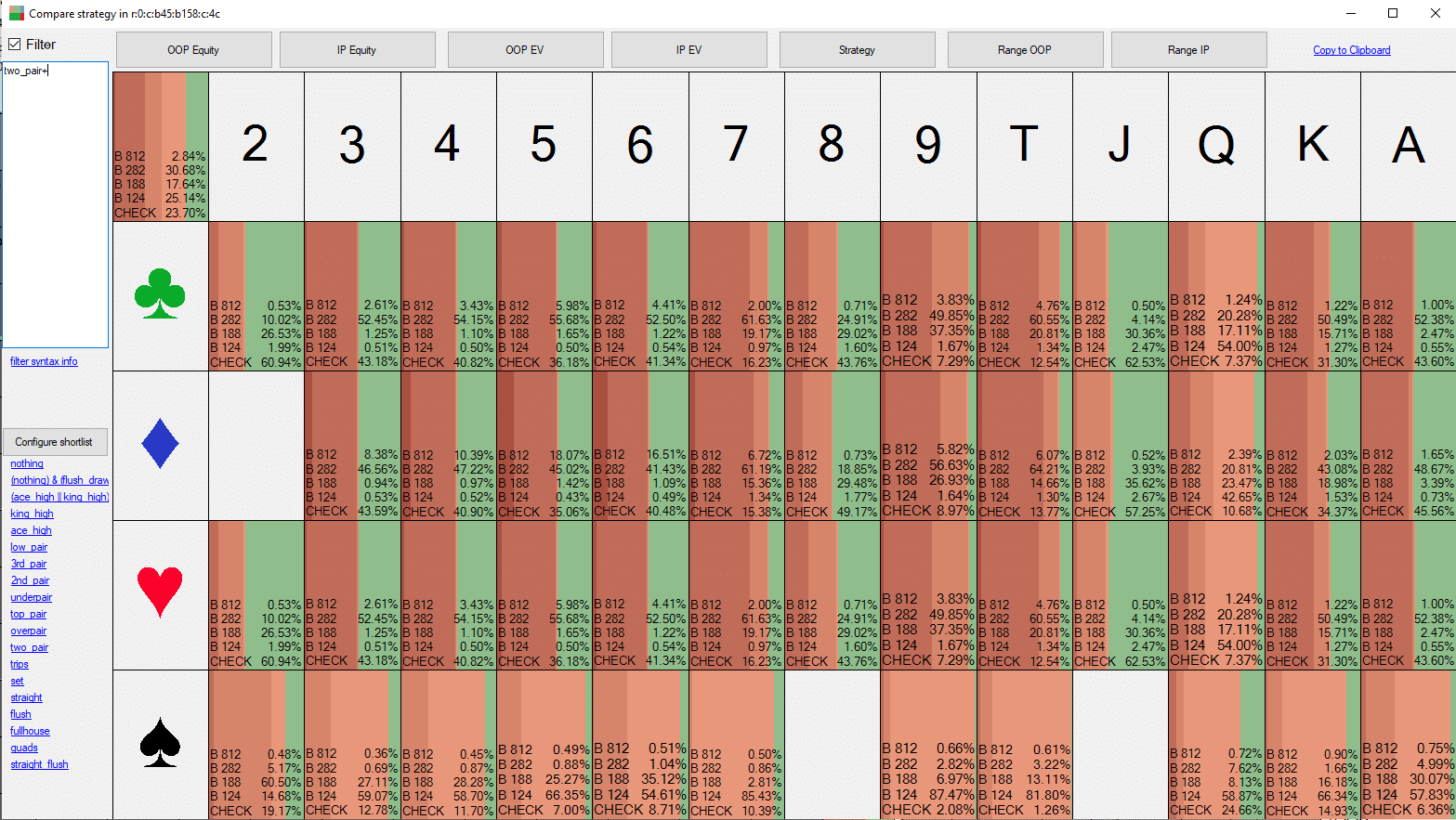
Optimum Guess Sizing on Clean Turns
To wrap up this part, let’s speak about optimum wager sizing.
Each time your vary is polarized and your opponent’s vary is merged, you typically need to use a bigger sizing. This strategy maximizes worth together with your sturdy fingers, creates enough room for bluffs (since smaller bets require fewer bluffs to stay balanced), and applies the correct quantity of mathematical strain to an opponent holding a bluff-catcher-heavy vary.
That mentioned, overbetting at this SPR isn’t optimum. It tends to extract barely much less worth, achieves much less fairness denial, and likewise diminishes the pair-out worth of your attracts—particularly in comparison with betting round 75% pot and persevering with to barrel on the river.
Solver Strategy by Hand Class
Now let’s get our heads out of the clouds and into the nitty-gritty. How does the solver really strategy these turns throughout totally different hand lessons?
In two phrases: very passive.
Since all twelve of those runouts behave virtually identically, right here’s the typical solver technique for every class:
- Two-pair+ – 40% barrel
- Prime pairs – 15% barrel
- Center pairs – 50% barrel (These make glorious merge bets, folding out some high pairs whereas getting known as by stronger attracts and blocking the Button’s two-pair+ area).
- Third pairs – 50% barrel
- Sometimes pair+draw fingers, which additionally perform effectively as merge bets.
- Fourth pairs – 50% barrel
- Additionally stable merge bets.
- Combo attracts – 25% barrel
- Flush attracts – 25% barrel
- Open-enders – 25% barrel
- Gutshots – 0% barrel
Exploitative Alternatives
There are two essential classes of errors your opponent could make on this spot: betting too continuously or not betting sufficient.
The anticipated worth of checking your sturdy fingers assumes that your opponent will stab at round 60% frequency on these clean turns—betting most of his high pairs and overpairs, together with roughly half of his attracts (some extra typically than others).
All else being equal, if you happen to anticipate your opponent to test again too typically with both of those hand lessons, checking your self solely lets him notice fairness totally free extra continuously. Your worth fingers additionally miss the prospect to develop the pot.
In that case, the optimum exploitative response is to take the initiative—betting your sturdy fingers to make sure that the pot will increase and your fairness realizes extra constantly.
Right here’s a snapshot from the solver on the 3c flip. The primary picture reveals the out-of-position participant’s GTO technique, whereas the second displays the adjusted technique after accounting for the brand new enter.
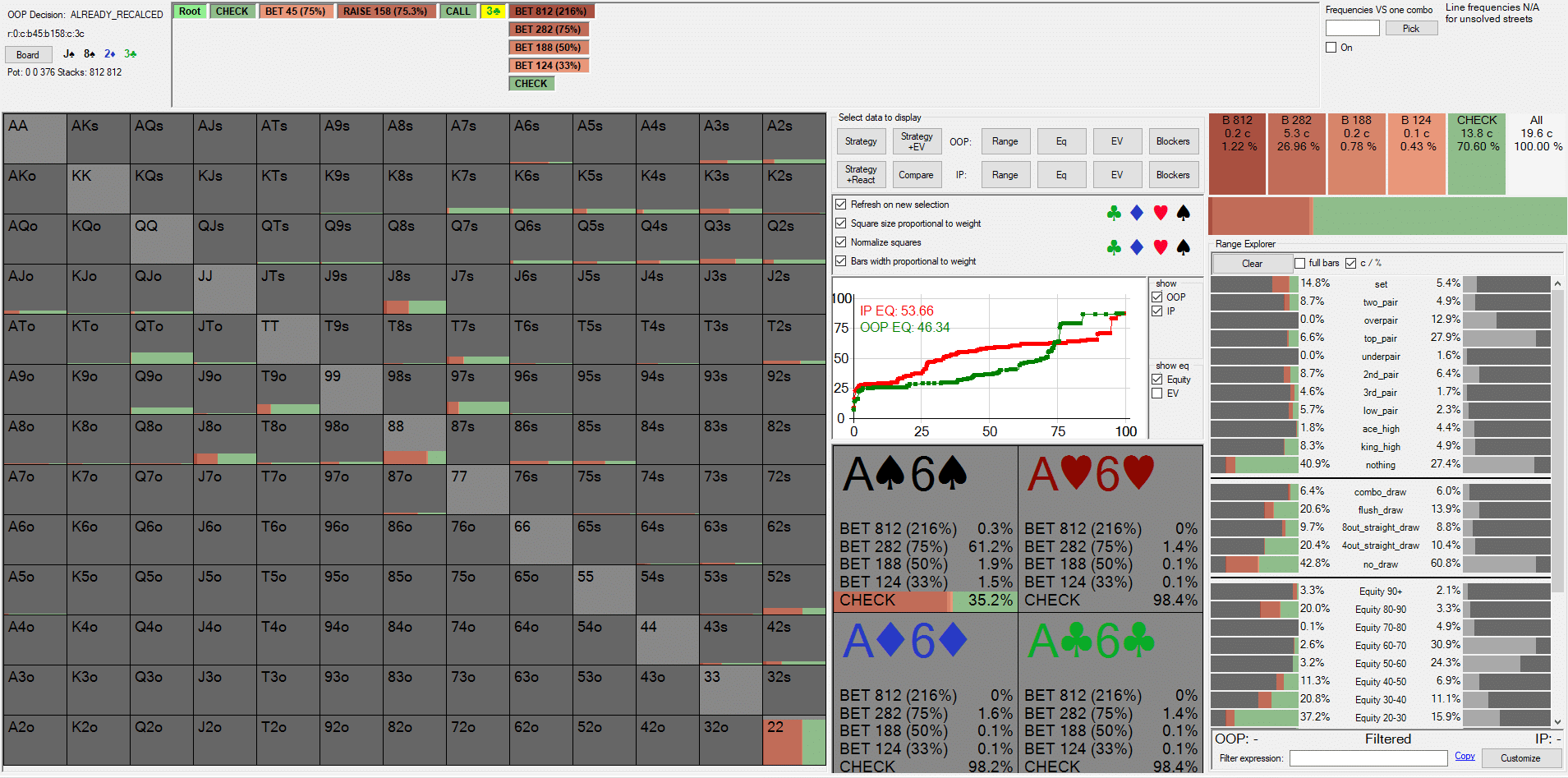
(GTO)
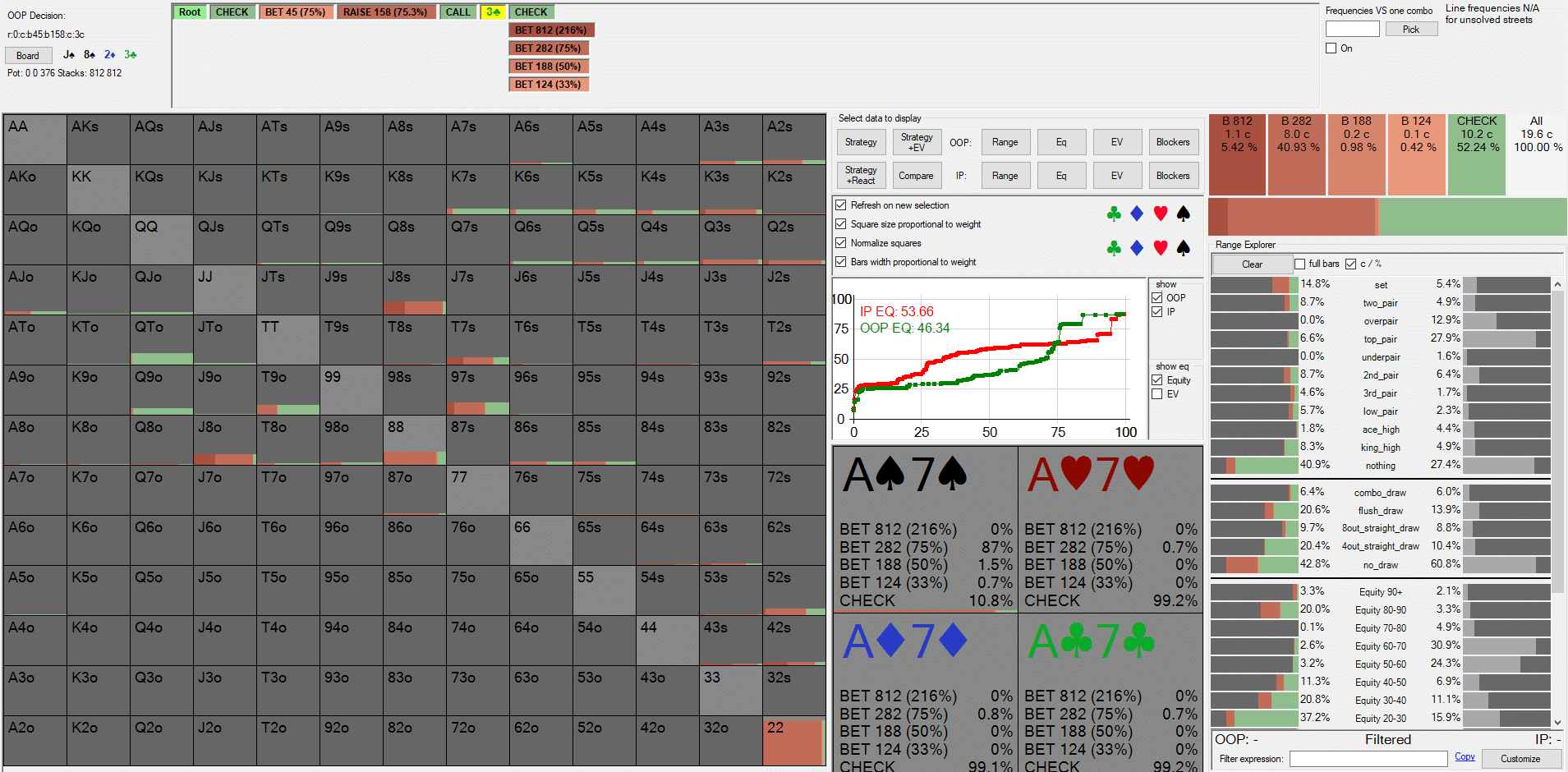
(vs an opponent who stabs solely 42% of the time in comparison with the optimum GTO frequency of 58%)
Conversely, in case your opponent is extra aggressive than the solver expects, he’s placing cash into the pot extra continuously when checked to. In that case, it not is sensible to gradual play your sturdy fingers, nor to decelerate together with your attracts.
On your sturdy fingers, this adjustment works as a result of you’ve gotten a greater alternative to develop the pot—by checking, letting your opponent overbluff, after which elevating to extract most worth.
On your attracts, nonetheless, the alternative is true. In opposition to an over-aggressive opponent, you received’t get to appreciate your fairness as typically—or as cheaply—as you’ll within the GTO mannequin.
In the case of taking part in attracts optimally, the state of affairs will get a bit extra nuanced.
If we assume the Button’s technique stays static GTO in all different nodes—that means he performs completely all over the place apart from his flip stab frequency, and received’t modify to modifications in your flip or river technique—then one of the best response is to maintain barreling your attracts.
Right here’s why: you’d generate much less EV within the checking line (because you’re getting denied extra typically) whereas nonetheless sustaining the identical EV within the betting line, as you’re the one forcing folds and realizing your fairness.
Nonetheless, if the Button is over-bluffing his flip stab however not betting the proper variety of worth fingers, then check-shoving turns into your highest-EV line. In that case, you’ll have him overfolding in a bigger pot, and at the next line frequency than what happens in GTO play.
Beneath, you possibly can see the Button’s GTO technique vs. test, adopted by the node-locked model I created for example the adjustment:
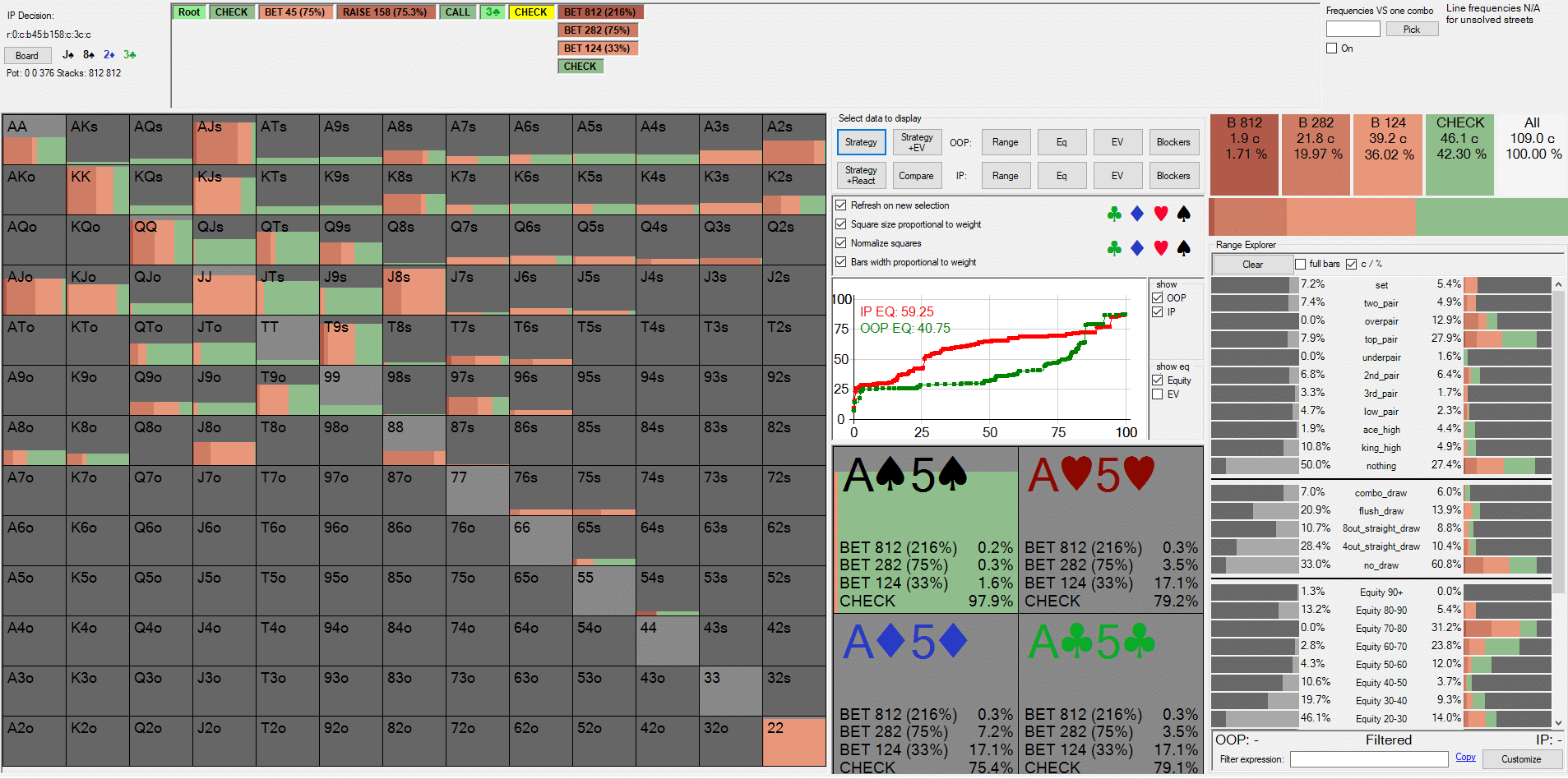
(GTO)
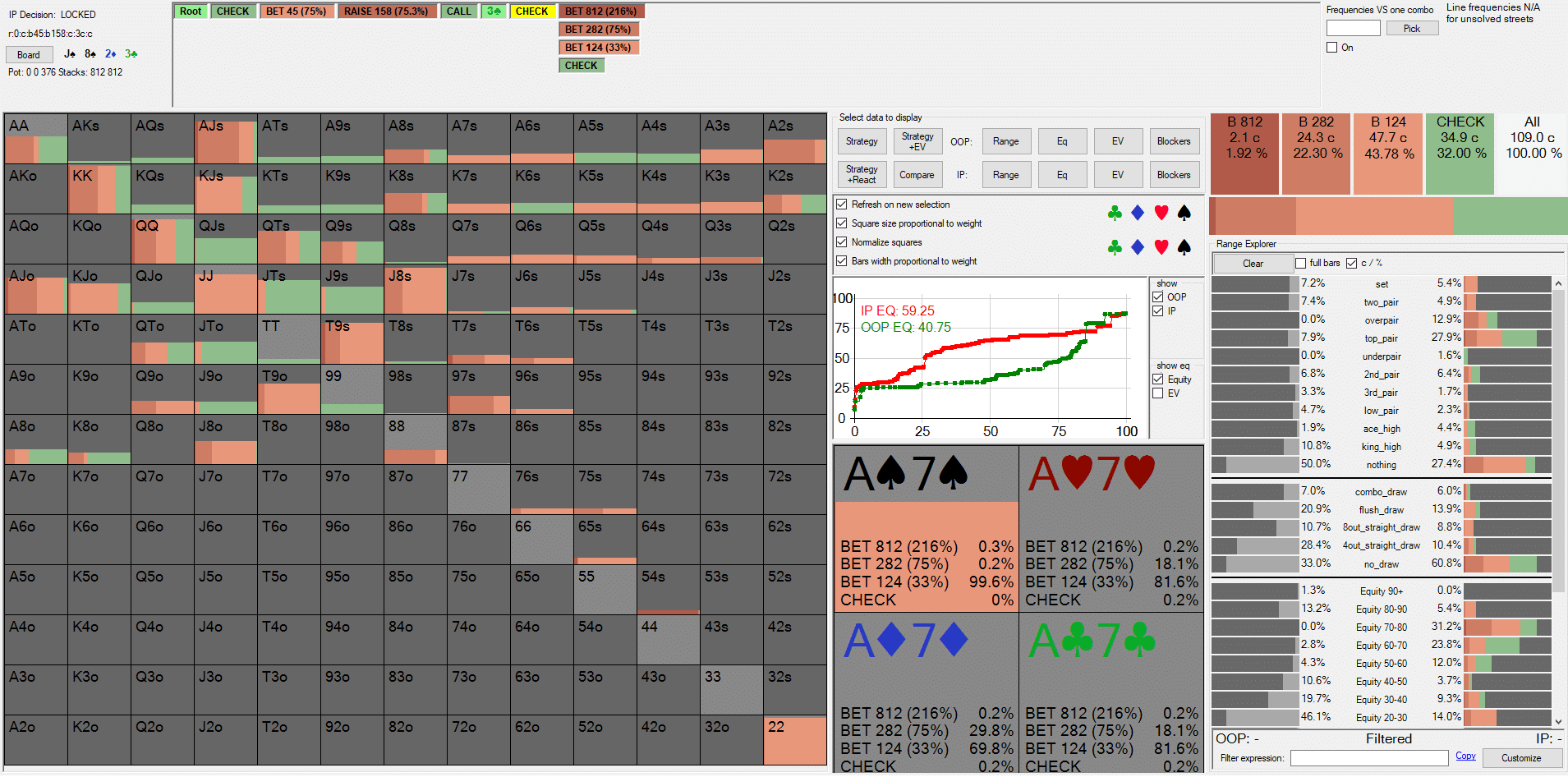
(I stored the identical betting frequencies for made fingers and solely elevated the betting frequency of the attracts)
Right here’s the brand new optimum barreling technique for the BB:
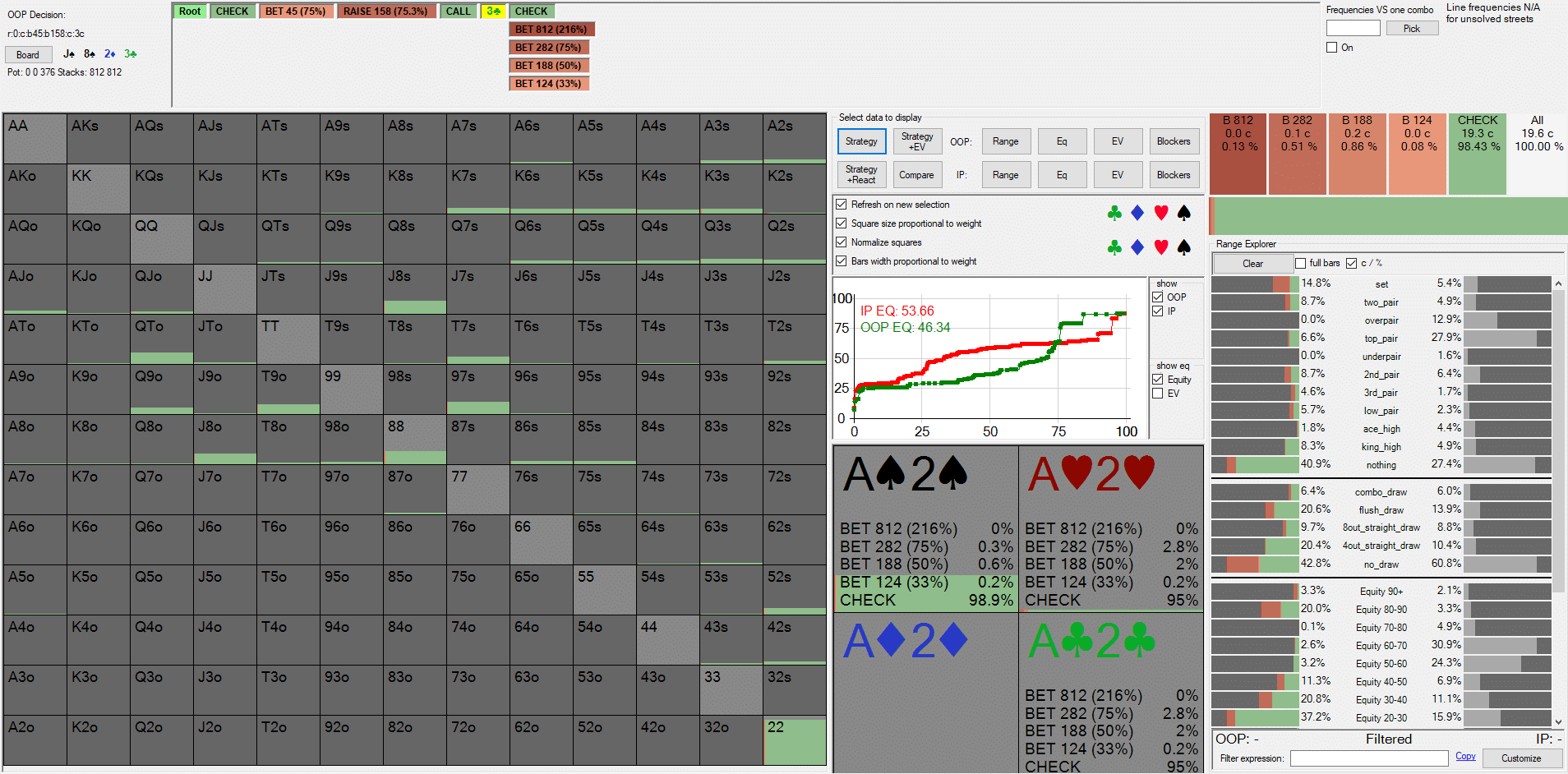
And right here’s how the solver performs in opposition to the weaker betting vary:
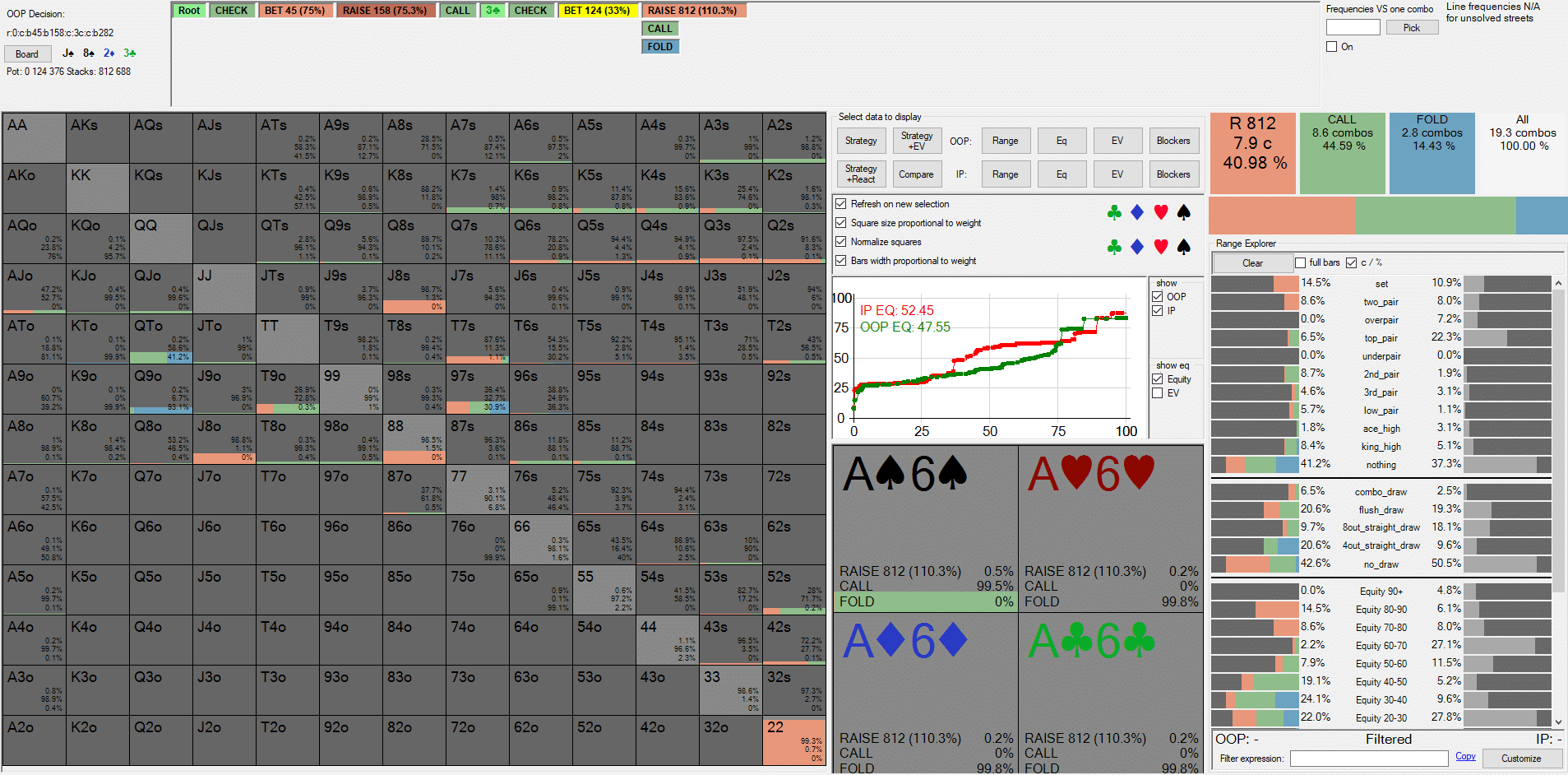
(in opposition to a 30% pot stab – we are able to see an enormous check-raising frequency, as much as 41% from 23% in GTO and likewise a check-fold frequency of solely 14% in comparison with 34% in GTO)
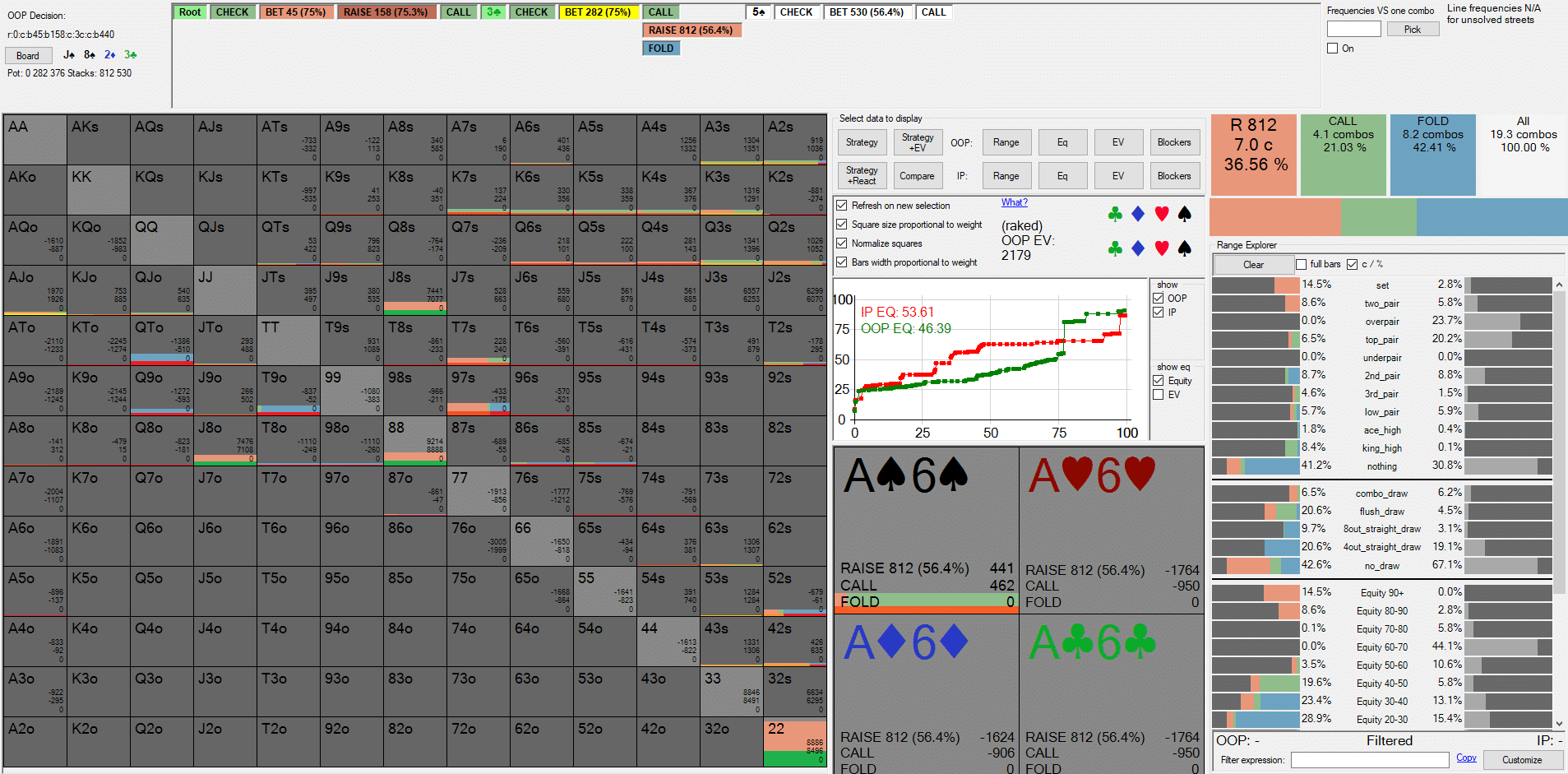
(in opposition to a 75% pot stab – we are able to see a 37% check-raise frequency in comparison with the GTO considered one of 22%, and a 42% check-folding frequency, down from 60% in GTO).
The Takeaway
I need you to note two ranges of strategic adaptation right here:
- Node-level (reactive) – the place we see extra check-raising and fewer check-folding in opposition to the opponent’s unbalanced flip stab.
- Earlier-node stage (proactive) – the place we strengthen our checking vary in anticipation of a weaker-than-optimal flip stabbing frequency.
This two-layered strategy is tough to know conceptually and even more durable to execute in actual time—however mastering it would considerably improve your edge. The primary stage exploits the leak; the second stage magnifies it by growing how typically it happens.
That’s all for this a part of the collection! I hope you loved it and picked up one thing new alongside the way in which. Within the remaining installment, we’ll break down pairing turns—the brickest of bricks.
Til subsequent time, good luck, grinders!
To be taught extra about taking part in turns after check-raising flop, learn: How To Play Overcard Turns After Examine-Elevating the Flop.

